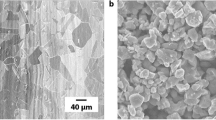Abstract
Rotary ultrasonic grinding machining (RUGM) is regarded as the most powerful machining method for engineering ceramic. However, there are micro-cracks on the machined surface inevitably for lower fracture roughness of material. As part of surface integrity, effective parameter and unified criterion are not proposed for micro-crack evaluation. In the paper, surface micro-crack evaluation of engineering ceramics by RUGM was investigated. Micro-crack generation area ratio calculation model and information dimension calculation model were established. On the basis of those, a new evaluation parameter, called micro-crack fractal density, was proposed to reveal the characteristics of micro-crack. The parameter was proved to evaluate micro-crack evolution rule effectively with the advantages of statistics and multi-scale. Meanwhile, the factors affecting micro-crack fractal density evaluation were investigated. It is found that the micro-crack fractal density increases with cutting force rising, while it decreases as fracture toughness rises. The results provide the support for surface integrity evaluation of engineering ceramics.
Similar content being viewed by others
References
Pei ZJ, Ferreira PM (1998) Modeling of ductile-mode material removal in rotary ultrasonic machining. Int J Mach Tools Manuf 38(10–11):1399–1418. doi:10.1016/S0890-6955(98)00007-8
Pei ZJ, Ferreira PM, Kapoor SG, Haselkorn M (1995) Rotary ultrasonic machining for face milling of ceramics. Int J Mach Tools Manuf 35(7):1033–1046. doi:10.1016/0890-6955(94)00100-X
Liang ZC, Wu C, Pei ZJ, Treadwell C (2006) Edge-chipping reduction in rotary ultrasonic machining of ceramics: finite element analysis and experimental verification. Int J Mach Tools Manuf 46(12–13):1469–1477. doi:10.1016/j.ijmachtools. 2005.09.002
Sanjay A, Rao PV (2008) Experimental investigation of surface/subsurface damage formation and material removal mechanisms in SiC grinding. Int J Mach Tools Manuf 48(6):698–710. doi:10.1016/j.ijmachtools.2007.10.013
Sanjay A, Rao PV (2010) Grinding characteristics, material removal and damage formation mechanisms in high removal rate grinding of silicon carbide. Int J Mach Tools Manuf 50(12):1077–1087. doi:10.1016/j.ijmachtools.2010.08.008
ISO/TS CD 25178–2 (2006) Geometrical product specification (GPS)-surface texture: areal-part 2: Terms, definitions and surface texture parameters
Yao ZQ, Gu WB, Li KM (2012) Relationship between surface roughness and subsurface crack depth during grinding of optical glass BK7. J Mater Process Technol 212(4):969–976. doi:10.1016/j.jmatprotec.2011.12.007
Miller PE, Suratwala TI, Wong LL, Feit MD, Menapace JA, Davis PJ, Steele RA (2005) The distribution of subsurface damage in fused silica. Laser Induc Damage Opt Mater 5991:1–25. doi:10.1117/12.638821
Lv DX, Huang YH, Tang Y, Wang HX (2013) Relationship between subsurface damage and surface roughness of glass BK7 in rotary ultrasonic machining and conventional grinding processes. Int J Adv Manuf Technol 67(1–4):613–622. doi:10.1007/s00170-012-4509-1
Chen SG, Lin B, Han XS, Liang XH (2013) Automated inspection of engineering ceramic grinding surface damage based on image recognition. Int J Adv Manuf Technol 66(1–4):431–443. doi:10.1007/s00170-012-4338-2
Lin B, Zhu HT, Wu H, Wang ZF, Yu SY (2004) Evaluation and measurement of surface/subsurface crack damage of ground ceramics. Mater Sci Forum 471–472(47):47–51. doi:10.4028/www.scientific.net/MSF.471-472.47
Akhavana A, Shafaatiana SMH, Rajabipourb F (2012) Quantifying the effects of crack width, tortuosity, and roughness on water permeability of cracked mortars. Cem Concr Res 42(2):313–320. doi:10.1016/j.cemconres.2011.10.002
Sun HQ, Zhou WH (2013) Fractal study for surface cracks of rubber concrete beam on concentrated load. Appl Mech Mater 419:412–417. doi:10.4028/www.scientific. net/AMM.419.412
Chen P, Wang EY, Ou JC, Li ZH, Wei MY, Li XL (2013) Fractal characteristics of surface crack evolution in the process of gas-containing coal extrusion. Int J Min Sci Technol 23(1):121–126. doi:10.1016/j.ijmst.2013.03.001
Yang S, Shao LT, Guo XX, Liu X, Zhao BY (2012) A crack segmentation approach using the combination of gray thresholds and fractal feature. Adv Mater Res 487:622–626. doi:10.4028/www.scientific.net/AMR.487.622
Jing JT, Zhao H, Liu YF, Wei SL (2013) Investigation on the cutting force of machining process for Si3N4 engineering ceramics. Int J Nanomanuf 9(2):148–163. doi:10.1504/IJNM.2013.055145
Lee TC, Chan CW (1997) Mechanism of the ultrasonic machining of ceramic composites. J Mater Process Technol 71(2):195–201. doi:10.1016/S0924-0136(97) 00068-X
Ya G, Qin HW, Yang SC, Xu YW (2002) Analysis of the rotary ultrasonic machining mechanism. J Mater Process Technol 129(1–3):182–185. doi:10.1016/S0924-0136(02)00638-6
Fang FZ, Zhang GX (2004) An experimental study of optical glass machining. Int J Adv Manuf Technol 23(3–4):55–160. doi:10.1007/s00170-003-1576-3
Liu YF, Zhao H, Jing JT, Wei SL (2011) Research on the material removal rate in rotary ultrasonic grinding machining. Int J Nanomanuf 7(2):158–168. doi:10.1504/IJNM.2011.040721
Liu JW, Baek DK, Ko TJ (2014) Chipping minimization in drilling ceramic materials with rotary ultrasonic machining. Int J Adv Manuf Technol 72(9–12):1527–1535. doi:10.1007/s00170-014-5766-y
Author information
Authors and Affiliations
Corresponding author
Rights and permissions
About this article
Cite this article
Shiliang, W., Hong, Z., Juntao, J. et al. Investigation on surface micro-crack evaluation of engineering ceramics by rotary ultrasonic grinding machining. Int J Adv Manuf Technol 81, 483–492 (2015). https://doi.org/10.1007/s00170-015-7195-y
Received:
Accepted:
Published:
Issue Date:
DOI: https://doi.org/10.1007/s00170-015-7195-y




